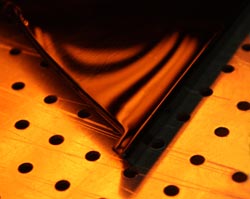Infrared Emitters Improve Lacquered Surfaces

Highly polished plastic surfaces are achieved with UV lacquers, whose curing is improved with the aid of infrared. Copyright Heraeus Noblelight 2012<br>
Many screens, internal claddings in cars and high value cosmetic packages are manufactured from plastics and contain a protective lacquer or finishing. The drying of the coating on the plastic components is not a trivial matter, for the surfaces need to be perfectly cured without applying to much heat to the plastic. Infrared heaters transfer energy in a contact-free manner and are easy to control. Consequently, the heat is precisely dispensed and the quality of the lacquered surface is improved.
The combination of infrared heat and UV lacquers is innovative. On one hand, the energy efficiency of the lacquer curing is improved and on the other hand the curing itself is significantly better through the pre-heating.
Heraeus Noblelight is presenting infrared emitters in Hall 1 on stand 1519 at the Paint Expo exhibition, which takes place in Karlsruhe in April, when there will also be an opportunity for face-to-face discussions with application specialists.
Whether it is matt black or a high value shiny varnish, car interiors often feature decorative varnishes. Lipstick tubes, face cream containers and powder compacts often have to provide some indication of their high value contents. These containers are manufactured in plastics, as are switches and levers in cars, and are then improved by coating. This is where UV lacquer is often used.
Energy-Efficiency in Lacquer Drying
UV powder lacquer is heated by infrared emitters to around 100-120ºC and then cured using UV radiation. As opposed to the curing of conventional powder lacquers, there is no need for any further heating. In this way, functional components can be coated exceptionally energy-efficiently and coating/curing plants have minimum space requirements. All infrared emitters, which are easy to control and regulate, like short wave, fast-response medium wave and carbon infrared emitters with response times in the order of seconds, are well suited for melting powder lacquer before UV curing.
Infrared emitters transfer energy in a contact-free manner and generate heat directly in the material. As a result, there is minimum air movement during heating unlike hot air ovens. Consequently, infrared drying minimizes the danger of dust inclusions in the lacquer and improves surface quality.
Quality Improvement by Using Infrared with UV Lacquers
Some plastic surfaces have a scratch-resistant lacquer, providing a mirror surface. This prevents fingerprints from spoiling the high gloss finish or hand- or sun creams from attacking the plastic.
These varnishes are often UV varnishes, which use UV radiation to initiate the curing. This curing is carried out much better at higher temperatures or it can even be optimized by pre-heating. For this reason, plastic components of radio screens, selector levers or lipstick tubes are first pre-heated with infrared. If the UV lacquer is melted first by the heat and then cured with the UV radiation, the surface quality is improved.
Infrared heat is then always used when heating processes must meet particular specifications in terms of space, throughput or quality. Infrared emitters can be precisely matched to product and process and this saves energy and costs.
Heraeus Noblelight GmbH with its headquarters in Hanau and with subsidiaries in the USA, Great Britain, France, China and Australia, is one of the technology- and market-leaders in the production of specialist light sources. In 2010, Heraeus Noblelight had an annual turnover of 98.9 Million € and employed 689 people worldwide. The organisation develops, manufactures and markets infrared and ultraviolet emitters for applications in industrial manufacture, environmental protection, medicine and cosmetics, research, development and analytical measurement techniques
The precious metals and technology group Heraeus headquartered in Hanau, Germany, is a global, family company with 160 years of tradition. Our businesses include precious metals, sensors, dental and medical products, quartz glass, and specialty lighting sources. With product revenues of € 4.1 billion and precious metal trading revenues of € 17.9 billion, as well as over 12,900 employees in more than 120 companies worldwide, Heraeus holds a leading position in its global markets.
For further information, please contact:
Technical:
Heraeus Noblelight GmbH
Reinhard-Heraeus-Ring 7
D-63801 Kleinostheim
Tel +49 6181/35-8545, Fax +49 6181/35-16 8545
E-Mail hng-infrared@heraeus.com
Press:
Dr. Marie-Luise Bopp
Heraeus Noblelight GmbH,
Abteilung Marketing/Werbung
Tel +49 6181/35-8547, Fax +49 6181/35-16 8547
E-Mail marie-luise.bopp@heraeus.com
Media Contact
More Information:
http://www.heraeus-noblelight.com/infraredAll latest news from the category: Trade Fair News
Newest articles

Properties of new materials for microchips
… can now be measured well. Reseachers of Delft University of Technology demonstrated measuring performance properties of ultrathin silicon membranes. Making ever smaller and more powerful chips requires new ultrathin…

Floating solar’s potential
… to support sustainable development by addressing climate, water, and energy goals holistically. A new study published this week in Nature Energy raises the potential for floating solar photovoltaics (FPV)…

Skyrmions move at record speeds
… a step towards the computing of the future. An international research team led by scientists from the CNRS1 has discovered that the magnetic nanobubbles2 known as skyrmions can be…





















